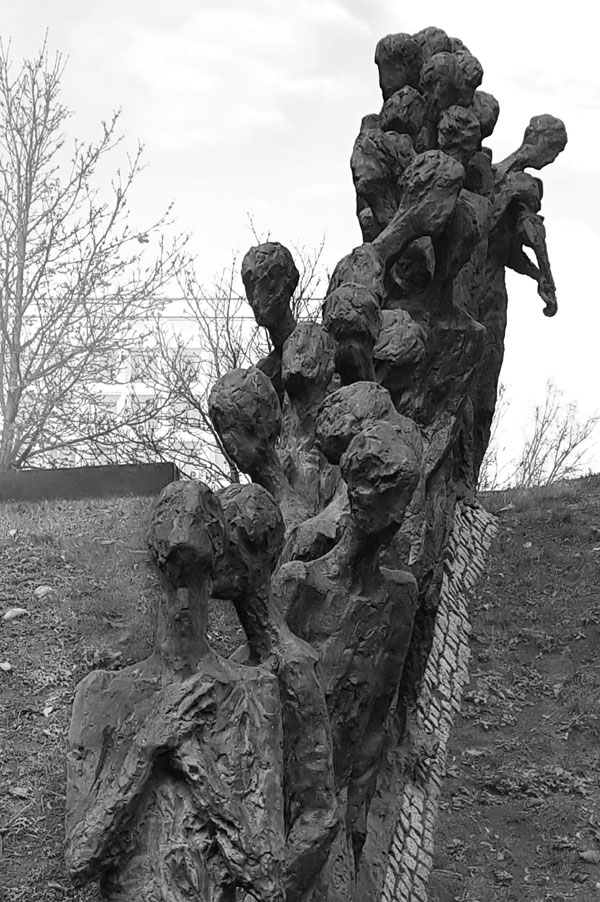First featured in the August 2020 issue of Torch magazine, CUFI’s Alastair Kirk shares his experience of visiting ‘The Pit’ in the Belarusian capital of Minsk.
In 1939, almost one third of the total population of Minsk was Jewish. According to the last census before the War, there were around 100,000 Jews living in the Belarusian capital and the figure initially rose by half again at the start of the War due to Jews fleeing eastwards to escape the German advance. Sadly, by the end of the Holocaust, two out of every three Jews living in the country had been murdered by the Nazis.
When German forces seized Minsk in June 1941, thousands of Jewish men aged 15 to 45 who reported for registration as intelligentsia (a highly educated social class) were taken and immediately shot. Next month, the notorious Minsk Ghetto was created not far from the city centre and all Jews in the city had five days to move there. Today, the area consisting of around 40 streets and crossroads in the north-western part of the city has very little sign of its former purpose. The ghetto was like a slave labour camp. It was completely cut off from the outside world – a place of hunger, hardship and fear. It was common for thousands of inmates to not return from labour. Many were taken into forests and shot to make space in the ghetto for Jews transported from Germany, Austria and Czechoslovakia. In one day alone in November 1941, 12,000 were seized, taken outside the city to pits and machine-gunned to death. Although the Minsk Ghetto was one of the largest ghettos in the Soviet Union at the time, little was known about its history.

You have to look very hard to retrace the steps of the Holocaust in Minsk, a city that was all but flattened by the Germans. But one very important and powerful landmark that is a must visit on a trip to Minsk is the Yama Memorial, known in English as The Pit, which is located in the area of the former ghetto and honours all Jewish victims of the Holocaust in Belarus.
After patiently trying to navigate the GPS, we eventually arrived at the destination – a 20-minute walk from Minsk’s historic centre. All we found was a wide crossroads with busy traffic surrounded by tall apartment buildings. But on the corner, set back from the road, was a cluster of trees and grass. As we walked into the small woodland area it was like stepping from the present into the past. The hustle and bustle of fast-paced Minsk was placed on pause. Suddenly we were faced with a large open space with a circular basin in the earth with sloping banks and steps that led down to the bottom. It felt solemnly quiet.
Welcoming visitors before the steps is a menorah constructed of red stone and plaques written in Russian. Parallel to the steps is a bronze sculpture called The Last Way, added in 2000 by the Belarusian artist and Chairman of the Jewish communities of Belarus, Leonid Levin, and the sculptor Elsa Pollak from Israel. The sculpture took 8 years to create and was crafted entirely by hand. It depicts 27 of the 5,000 Jewish victims from the ghetto who were forced to descend into The Pit to their execution on 2 March, 1942.
On that horrific day, which coincided with the Jewish festival of Purim, after workers had left the ghetto, the Nazis ordered that children from an orphanage be brought to the administration building. Unaware of what awaited the children, their supervisors led them, dressed and washed, and carrying the youngest in their arms, toward the building. They were met by a German officer who greeted them with sweets before leading them into a newly dug pit in the centre of the ghetto. They were buried alive. Later that day when workers returned to the ghetto, the Nazis rounded up more victims and shot them in the same pit.
The proximity of the sculpture to the steps mean that as you descend into the pit, you are momentarily walking in the footsteps of those 5,000 victims. As you walk down, one cannot help but observe the individuals depicted in the sculpture. Faces have few details and their outlines are obscure; their stories are a mystery and their names are unknown, yet vividly to the point of almost being real, the sculpture shouts out fear, grief, pain and sorrow. Some of the figures prefer to not look down, other faces cry death, some are looking heavenwards. Little children are snuggled between the adults as if to deliberately protect them from the horror. Some figures are touching the person in front, but are about to be separated. Another character is holding a violin, perhaps out of defiance or distraction, drowning out the sound of gunshots with tunes of comfort and strength.
There are 18 steps – the number 18 is synonymous with the Hebrew word chai חַי, which means life or living. Like the sculpture, the cobblestone floor in the centre of the pit was laid by hand out of respect for the victims.
Standing in the centre of the open space, one feels a sense of vulnerability with only the towering apartment blocks and silent trees staring as you stand isolated. There is a feeling of emptiness with nothing to see except your stationary surrounding, yet you feel obligated to stand and wait a moment to take in the magnitude of the atrocity. So moving is the experience that no length of time is sufficient to fully contemplate such evil. According to one source, authorities during the era when Belarus was under Soviet rule regularly threatened to fill in the entire pit. One more visitor is one more remembrance to ensure this never happens. Whilst we are offended by the cruelty we are appreciative that the memorial exists.


Continuing to the other side of the pit, we come to an obelisk, placed by former prisoners in 1947. It was the first monument within the former Soviet Union that paid tribute to the victims of the Holocaust, although the first public ceremony for the Holocaust took place there in 1991 after Belarus gained independence. It is inscribed in Yiddish, with Hebrew letters, and Russian. There are no English translations here. A poet named Chaim Maltinski wrote (translated), “In bright remembrance for all eternity of the 5,000 Jews who perished at the hands of the cruel enemies of humanity — the Nazi criminals, March 2, 1942”. The Russian word translated ‘criminals’ here is so strong there isn’t an English equivalent. The closest would be the word ‘monsters’. Indeed, events at The Pit formed part of many more systematic murders, including mass shootings, deportations to concentration camps, and the notorious gas vans that were brought into the city that further depleted Minsk’s Jewish population.

According to Nazi records, 86,632 Jews had been murdered in Minsk by 1 February 1943. Over the next few months, the Germans began the liquidation of the ghetto. Shootings became commonplace to the point that people were too fearful to go outside. Orphaned children, the elderly and the disabled were systematically annihilated. And with most Jewish doctors now killed, German soldiers would enter the hospitals and shoot patients. In the summer of 1943, several thousand Jews were transported from the ghetto to concentration camps. By October that year, the 2,000 Jews that remained in the ghetto were rounded up and shot with only a handful somehow managing to escape by hiding. Minsk was liberated by the Red Army on 3 July 1944.
We exit the pit on the opposite side to the sculpture and ascend to the surface. As we follow a narrow circular footpath to return to the entrance, our walk is lined by tall lime trees. Under each tree there is a plaque dedicated to Belarusian non-Jews who gave their lives trying to save Jews. Some of these would have been part of Belarus’s famous partisan or underground movement. The partisans’ cooperation with the Jewish resistance movement within the ghetto led to many Jews escaping. Many Belarusians risked their lives and those of their families by rescuing refugees from the ghetto and hiding them in their houses and apartments. Some took Jewish children under Russian names or placed them in children’s homes.
With the leafy branches gently swaying above us, suddenly the feeling of emptiness experienced in the pit turns to life. A reminder that amid such horror and atrocity, there were those who did all to preserve life. And as the trees bring forth new life in season, the legacy of those brave individuals is breathing new life today. We’re reminded that the Jewish people live on – the evil Nazi monsters failed to stop the Jewish people thriving or the rebirth of the Jewish nation.
Today, Belarus’s significant Jewish history is still largely undiscovered. There is a small section on Jewish life in the impressive National War Museum, only a short walk away from The Pit. Exhibits retell the conflict on the eastern front in which one out of three Belarusians died, and explains Belarus’s effective partisan movement. But for a more thorough history specifically on the Holocaust, there is a small museum called Museum of the History and Culture of Jews of Belarus. And in recent years, more people from outside Belarus are retracing their Jewish heritage with private tours now available. With Belarus slowly relaxing its strict border controls that have previously limited tourism, more people may take the opportunity to make their own discoveries.












